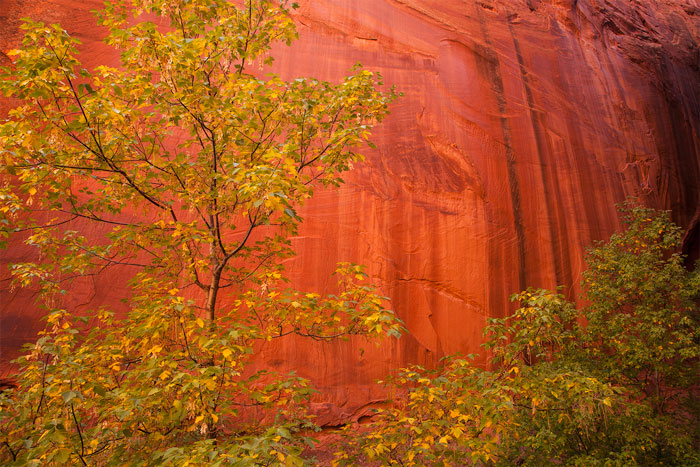
October 2012
Grand Staircase - Escalante National Monument, UT, USA
Canon 5D MkII & EF 24-105mm f/4L IS USM, 0.3s f/11 ISO400 @24mm
If you ask what is my favourite place on Earth, the answer is straightforward: the Colorado Plateau. I doubt the above statement will ever change, because although there are many places on this planet I have not visited, first I doubt there is anything out there that can be compared with it, and second most likely than not I will never visit it, specially if I keep coming back to the Colorado Plateau whenever I have a chance. And if you then go on and ask what is my favourite location within the Plateau, it may take slightly longer to answer but I will always reach the same conclusion: the Escalante Canyons. I also have little doubt that this will ever change, for the simple reason that there are few places left in the Plateau where I have never been. Had I been born fifty years earlier, the answer may have been Glen Canyon; but this statement is based on the stories and black and white photos from the very few people lucky enough to explore it before it was drowned by the rising waters of Lake Powell. I will never see the Colorado River flowing free and lazy through Glen Canyon, so I'll try to compensate by setting my eyes on every corner of the maze of canyons carved by one of its tributaries: the Escalante.
If I had to summarize my memories about the Escalante Canyons, I guess I could do it with three simple words: orange, green, and balance. The proportions and details may change, but the three elements are always there. Orange, reddish orange, or orangish red, however you want to look at it, from the rocks; green, yellowish green, or greenish yellow, in this case not up to you but to the season of the year, from the riparian vegetation; and balance, because to me everything within these canyons, be it dead or alive, solid or liquid, dry or humid, orange or green, is in perfect equilibrium with everything that surrounds it. The fact that red and green oppose each other within the color wheel may help explain this balance, but there is more to it. Everything feels pure within the canyons, pristine, without excesses.
The Escalante region is composed exclusively of three different rock formations: the Navajo Sandstone on top, the narrow Kayenta formation in the middle, and the Wingate Sandstone on the bottom1. From far away they look like peanut butter squeezed between two immense chunks of bread. Each layer is beautiful by itself, and together they characterize this region and are known as the Glen Canyon Group because they were also the main rocks along that now defunct peaceful stretch of Colorado River. The Wingate is the most striking of the three, although awesome and delightful are also valid adjectives. Composed of homogeneous fine grains of sand, it forms striking cliffs hundreds of feet high that are an impassable barrier to travel. Its color is often extremely saturated, specially when basked with soft warm light from the other side of the canyon.
Quite often the homogeneity of the enormous Wingate cliffs is broken by vertical stripes of darker reddish rock called "desert varnish". Their locations coincide with the waterfalls that springboard off the cliffs during rainstorms. The combination between the sporadic humidity from the waterfalls, the bacteria and micro fungi present in the rock surface, and clay particles of iron and manganese (most often wind blown, although both minerals may also be present in the rock) forms these stripes that often fully cover the hundreds of feet between the top of the cliffs and the canyon bottom.
Nothing better to balance the sheer size of the Wingate cliffs than the cottonwood. Kings of the canyons, cottonwoods love spring floods and the floodplains they form. Their roots need water and hence they never grow too far from it. In spring its fluffy seeds billow in the canyon wind; in summer its shocking green foliage and dark shade offer relief from the relentless heat; and in fall its leaves turn to gold.
Now look at the picture above. I see reddish orange, I see golden green, I see harmony, I see balance. For you most likely this is just a picture, a sight. For me, however, this is more than a sight and what I see; it is a feeling and what I felt, what I feel in these canyons whenever I am lucky enough to hike in there. I do not exaggerate if I say that I feel the Wingate, I notice the balance, I experience the cottonwoods. It is something far more intimate than to see, far more complex than just colors and balance in a photograph. The colors and the harmony are in there, but so is the music of the cottonwoods leaves blowing in the wind, the scent of the humid sand, the warmth of the reflected light, the toughness of canyon travel, and the danger of the flash floods. That is why I like it, and why I keep coming back. Once and again.
1There exist two additional formations, the Carmel and the Chinle, but they are quite uncommon.